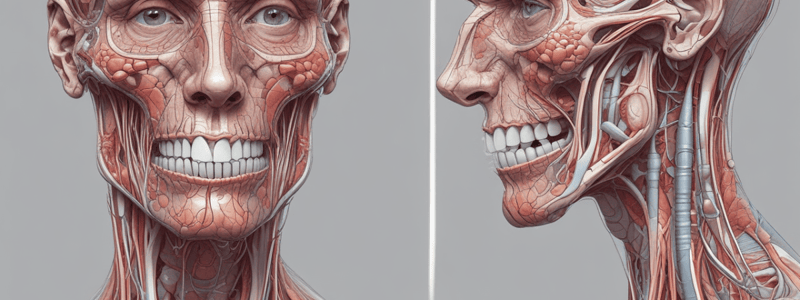Podcast
Questions and Answers
Which nerve supplies the parotid gland?
Which nerve supplies the parotid gland?
- Auriculotemporal nerve (correct)
- Facial nerve
- Lingual nerve
- Glossopharyngeal nerve
What is the name of the duct associated with the submandibular gland?
What is the name of the duct associated with the submandibular gland?
- Stensen's Duct
- Wharton's Duct (correct)
- Sublingual Duct
- Parotid Duct
Which of the following vessels supplies blood to the submandibular gland?
Which of the following vessels supplies blood to the submandibular gland?
- Posterior auricular artery
- External carotid artery
- Lingual artery
- Facial artery (correct)
What is the weight of the submandibular gland?
What is the weight of the submandibular gland?
What is the classification of salivary glands based on their size?
What is the classification of salivary glands based on their size?
Where is the sublingual salivary gland located?
Where is the sublingual salivary gland located?
What is the type of gland that salivary glands belong to?
What is the type of gland that salivary glands belong to?
What is the shape of the submandibular gland?
What is the shape of the submandibular gland?
What is the type of secretion found in salivary glands?
What is the type of secretion found in salivary glands?
Which of the following is a clinical consideration for the parotid gland?
Which of the following is a clinical consideration for the parotid gland?
What is the name of the vein that drains the submandibular gland?
What is the name of the vein that drains the submandibular gland?
What is the structure that divides the secretory units and ducts of salivary glands into lobes and lobules?
What is the structure that divides the secretory units and ducts of salivary glands into lobes and lobules?
What is the term for the components of salivary glands that are responsible for producing secretions?
What is the term for the components of salivary glands that are responsible for producing secretions?
What is contained within the connective tissue of salivary glands?
What is contained within the connective tissue of salivary glands?
Which type of gland is the adult parotid?
Which type of gland is the adult parotid?
Which of the following glands is not a minor salivary gland?
Which of the following glands is not a minor salivary gland?
What is the fifth stage in the development of salivary glands?
What is the fifth stage in the development of salivary glands?
What regulates the branching process in stage III of salivary gland development?
What regulates the branching process in stage III of salivary gland development?
Which gland is a mixed gland?
Which gland is a mixed gland?
What is the result of different rates of cell proliferation between the outer and inner layers of the epithelial chord?
What is the result of different rates of cell proliferation between the outer and inner layers of the epithelial chord?
What induces the overlying epithelium to proliferate during stage I of salivary gland development?
What induces the overlying epithelium to proliferate during stage I of salivary gland development?
What promotes stalk elongation during stage II of salivary gland development?
What promotes stalk elongation during stage II of salivary gland development?
Flashcards are hidden until you start studying
Study Notes
Salivary Glands
- Salivary glands are compound, tubuloacinar, merocrine, exocrine glands whose ducts open into the oral cavity.
- 2 main components: Parenchyme (secretory units) and Mesenchyme (connective tissue)
- Parenchymal elements: Oral epithelium, Secretory units
- Mesenchymal elements: Capsule, Connective tissue, Blood and lymph vessels, Nerve supply
Classification of Salivary Glands
- According to size:
- Major: Parotid, Submandibular, Sublingual
- Minor: Glands of lips, cheeks, hard & soft palate
- According to secretion:
- Purely serous: Adult parotid, Von Ebner gland
- Purely mucous: Palatine, Glossopalatine, Weber glands
- Mixed glands: Submandibular, Sublingual, Buccal, Labial, Blandin Nuhn glands
Parotid Gland
- Blood supply: External carotid artery
- Nerve supply: Auriculotemporal nerve
- Lymphatic drainage: Parotid nodes, Upper deep cervical nodes
- Clinical consideration: Mumps (infectious disease of salivary glands), Parotid abscess (may cause facial nerve damage)
Submandibular Gland
- Location: Submandibular triangle, behind free border of mylohyoid muscle
- Shape: Roughly J-shaped, divided into superficial and deep parts
- Weight: 10-15 gms
- Duct: Wharton's duct, thin-walled, 5 cm long, opens in floor of mouth on sublingual papilla
- Blood supply: Facial artery
- Lymphatic supply: Submandibular lymph nodes
- Nerve supply: Sensory fibers from lingual nerve
Sublingual Salivary Gland
- Smallest of three salivary glands
- Almond-shaped
- Weight: 3-4 gms
- Location: Above mylohyoid, below mucosa of floor of mouth, medial to sublingual fossa of mandible, lateral to genioglossus
Development of Salivary Glands
- Stages:
- Formation of bud
- Formation of chord
- Branching of chords
- Lobule formation
- Canalization
- Stage I: Bud formation (underlying mesenchyme induces epithelium to proliferate)
- Stage II: Formation of chord (epithelial bud proliferates, mesenchymal condensation proliferates)
- Stage III: Branching of epithelial chord (regulated by EGF and its receptors)
- Stage IV: Lobule formation (connective tissue forms capsule, surrounds glandular structure)
- Stage V: Canalization (chords form central tube or duct)
Studying That Suits You
Use AI to generate personalized quizzes and flashcards to suit your learning preferences.




